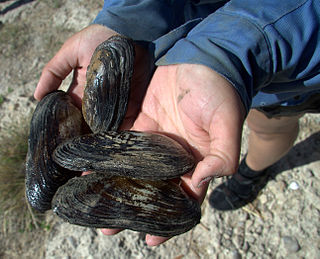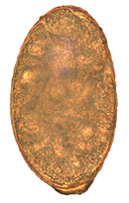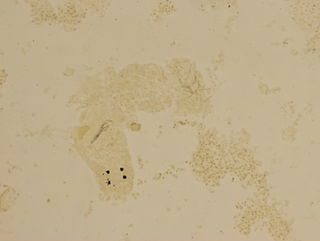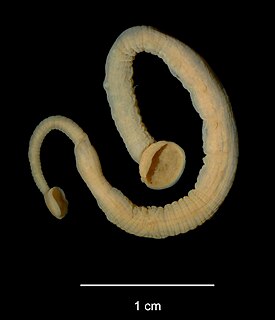
Monogeneans are a group of ectoparasitic flatworms commonly found on the skin, gills, or fins of fish. They have a direct lifecycle and do not require an intermediate host. Adults are hermaphrodites, meaning they have both male and female reproductive structures.

Haemonchus contortus, also known as the barber's pole worm, is a very common parasite and one of the most pathogenic nematodes of ruminants. Adult worms attach to abomasal mucosa and feed on the blood. This parasite is responsible for anemia, oedema, and death of infected sheep and goats, mainly during summer in warm, humid climates.

Necator americanus is a species of hookworm commonly known as the New World hookworm. Like other hookworms, it is a member of the phylum Nematoda. It is an obligatory parasitic nematode that lives in the small intestine of human hosts. Necatoriasis—a type of helminthiasis—is the term for the condition of being host to an infestation of a species of Necator. Since N. americanus and Ancylostoma duodenale are the two species of hookworms that most commonly infest humans, they are usually dealt with under the collective heading of "hookworm infection". They differ most obviously in geographical distribution, structure of mouthparts, and relative size.

Parasitic worms, also known as helminths, are large macroparasites; adults can generally be seen with the naked eye. Many are intestinal worms that are soil-transmitted and infect the gastrointestinal tract. Other parasitic worms such as schistosomes reside in blood vessels.

The Strongylida suborder includes many of the important nematodes found in the gastrointestinal tracts of ruminants, horses, and swine, as well as the lungworms of ruminants and the hookworms of dogs and cats.
The silver lamprey is a lamprey commonly found in the Northern and Central United States, as well as a large part of southern Canada. Its binomial name means "sucking fish" in Greek and "one-pointed" in Latin. The silver lamprey is a member of the Class Agnatha, sometimes referred to as cyclostomes (round-mouths). Other common names include: Bloodsucker, Blue Lamprey, Hitch-hiker, Lamper, Lamprey Eel. The silver lamprey should not to be confused with the sea lamprey, which has caused considerable damage to native fish populations in the Great Lakes region.

Popenaias popeii, common name the Texas hornshell, is a species of freshwater mussel, an aquatic bivalve mollusk in the family Unionidae, the river mussels.

The glochidium is a microscopic larval stage of some freshwater mussels, aquatic bivalve mollusks in the families Unionidae and Margaritiferidae, the river mussels and European freshwater pearl mussels.

The microfilaria is an early stage in the life cycle of certain parasitic nematodes in the family Onchocercidae. In these species, the adults live in a tissue or the circulatory system of vertebrates. They release microfilariae into the bloodstream of the vertebrate host. The microfilariae are taken up by blood-feeding arthropod vectors. In the intermediate host the microfilariae develop into infective larvae that can be transmitted to a new vertebrate host.

Nanophyetus salmincola is a food-borne intestinal trematode parasite prevalent on the Pacific Northwest coast. The species may be the most common trematode endemic to the United States.
Dactylogyrus is a genus of monogeneans in the Dactylogyridae family.

Dactylogyrus vastator is a species of hermaphroditic flatworms of class Monogenea. It is an ectoparasite of fish which infests the gills. It is problematic on fish farms. It is otherwise non-hazardous to humans.
Bothriocephalus acheilognathi, also known as the Asian tapeworm, is a freshwater fish parasite that originated from China and Eastern Russia. It is a generalized parasite that affects a wide variety of fish hosts, particularly cyprinids, contributing to its overall success.

Hydrachnidia, also known as "water mites", Hydrachnidiae, Hydracarina or Hydrachnellae, are among the most abundant and diverse groups of benthic arthropods, composed of 6,000 described species from 57 families. As water mites of Africa, Asia, and South America have not been well-studied, the numbers are likely to be far greater. Other taxa of parasitengone mites include species with semi-aquatic habits, but only the Hydracarina are properly subaquatic. Water mites follow the general parasitengona life cycle, which is characterized by parasitic, calyptostatic, and predaceous stages. They are ubiquitous in nearly all freshwater habitats of every continent except Antarctica. Typical habitats include streams and marshes, but may also be found in more obscure areas such as treeholes, hot springs, deep lakes and waterfalls. Some species have also adapted to marine environments. Water mites are unusual among freshwater invertebrates in being colorful, with brilliant reds and oranges being most obvious, but they also display more subtle blues, greens and yellows. They are also unusual among all mites in that some lineages have movable, internalized eye lenses sunk deep within the tissues of the prosoma rather than being set on the surface of the cuticle.

Lernaeocera branchialis, sometimes called cod worm, is a parasite of marine fish, found mainly in the North Atlantic. It is a marine copepod which starts life as a small pelagic crustacean larva. It is among the largest of copepods, ranging in size from 2 to 3 millimetres when it matures as a copepodid larva to more than 40 mm as a sessile adult.
Nicothoë astaci or the 'lobster louse' is an ectoparasitic copepod that parasitises the gills of the European lobster species Homarus gammarus. The lobster louse was first reported in 1826 by Audoin & Milne-Edwards. N. astaci has been found on lobsters inhabiting locations including Scotland, Lundy Island in the Bristol Channel and as far south as France and Portugal. The louse possesses a narrow suctorial mouthpart to feed on host haemolymph. Internally, In its adult form, Nicothoe is barely mobile and most likely remains in the same position for most of its life. The parasite occurs in groups, particularly near the base of the gills, and study has gone into its effects on the lobsters, which are considerably important, commercially. Not much is known about its life cycle, since there are significant gaps in knowledge of certain stages of its growth.

Bivitellobilharzia nairi is a species of trematodes, part of the family Schistosomatidae. It is most closely related to the blood fluke Bivitellobilharzia loxodontae, which uses African forest elephants as a definitive host. Each of these schistosomes, that are part of the genus Bivitellobilharzia, sit near the base of a branch within the schistosome family that contains mammal-infecting species. This is a fairly new identified endoparasite that was found in 1955 by Mudaliar and Ramanujachari, who first recorded the parasite in India. Researchers collected fecal samples of the Indian rhinoceros and were startled to find B. nairi eggs.

Parascaris equorum is a species of ascarid that is the equine roundworm. Amongst horse owners, the parasites are colloquially called "Ascarids". This is a host-specific helminth intestinal parasite that can infect horses, donkeys, and zebras. Horses up to six months of age are the most susceptible to infection. After this time, infection rates begin to decline and is extremely uncommon in horses over twelve months of age. It cannot infect humans or other animals. It is yellow-white in color, and females can become as large as 15 inches (38 cm) in length. Found worldwide, P. equorum is one of the most difficult equine parasites to kill, requiring larger doses of more powerful anthelmintic medications than are needed for other equine parasites.

Trachelobdella lubrica is a species of marine leech in the family Piscicolidae. It is a parasite of fish and has a worldwide distribution in the equatorial belt. It was first described in 1840 by the German zoologist Adolph Eduard Grube, the type locality being Palermo, Sicily, in the Mediterranean Sea.














